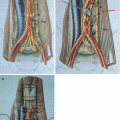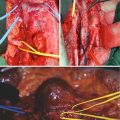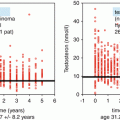Conventional–dose chemotherapy (CDCT)
VIP
Cisplatin
20 mg/m2
Days 1–5
4 cycles
Ifosfamide
1.2 g/m2
Days 1–5
Etoposide
75 mg/m2
Days 1–5
TIP
Cisplatin
20 mg/m2
Days 1–5
4 cycles
Ifosfamide
1.2 g/m2
Days 1–5
Paclitaxel
250 mg
Day 1
VeIP
Cisplatin
20 mg/m2
Days 1−5
4 cycles
Ifosfamide
1.2 g/m2
Days 1−5
Vinblastine
0.11 mg/kg
Days 1 + 2
Carboplatin
500 mg/m2
Days 1−3
3 cycles
Etoposide
500 mg/m2
Days 1−3
Carboplatin
AUC 8
Days 1−3
3 cycles
Etoposide
400 mg/m2
Days 1−3
Carboplatin
700 mg/m2
Days 1−3
2 cycles
Etoposide
750 mg/m2
Days 1−3
7.3 Prognostic Factors That Predict Treatment Response Abschnitt evt. Weglassen
The concept of therapy selection being guided by prognostic factors has been proven successful in first-line therapy and is now also being implemented in salvage therapy [10, 18]. However, the process of identifying prognostic factors in patients with relapsed and refractory tumors is being rendered more difficult by the fact that the data available are far more heterogeneous. While a range of prognostic factors have been known for some years, their wider acceptance and the introduction of a validated prognostic score have been rather recent developments (Table 7.2).
Histology in patients with refractory disease or at first relapse following first-line chemotherapy | ||
|---|---|---|
Favorable | Unfavorable | |
Histology | Seminoma | Nonseminoma |
Primary tumor location | All, except primary mediastinal nonseminomas | Primary mediastinal nonseminomas |
Response to first-line therapy | CR or PR with negative tumor markers | PR with positive markers or even worse |
Progression-free interval | More than 3 months after the end of first-line therapy | Less than 3 months after the end of first-line therapy |
Metastases at relapse | Only lymphatic or pulmonary metastases | Extrapulmonary organ metastases (liver, bone, CNS) |
Tumor markers at relapse | AFP low (≤1,000 ng/mL) | AFP high (>1,000 ng/mL) |
HCG low (≤1,000 U/L) | HCG high (>1,000 U/L) | |
Two years ago, an article was published that reported on the retrospective analysis of data collected on nearly 1,600 patients worldwide who presented with relapsed or refractory disease and who had received either CDCT or HDCT as initial salvage therapy. The research was able to identify seven independent variables with a significant impact on progression-free survival (PFS) and overall survival (OS) as well as being successful in developing a prognostic scoring system. A total of five prognostic categories were defined based on these variables. The 2-year PFS, estimated using the Kaplan-Meier method, was 75 % for patients in the very-low-risk group, 51 % for patients in the low-risk group, 40 % for patients in the intermediate-risk group, 26 % for patients in the high-risk group, and 6 % for patients in the very-high-risk group [1]. Patients with pure seminoma represented a separate subgroup among the five prognostic categories.
Stay updated, free articles. Join our Telegram channel

Full access? Get Clinical Tree






